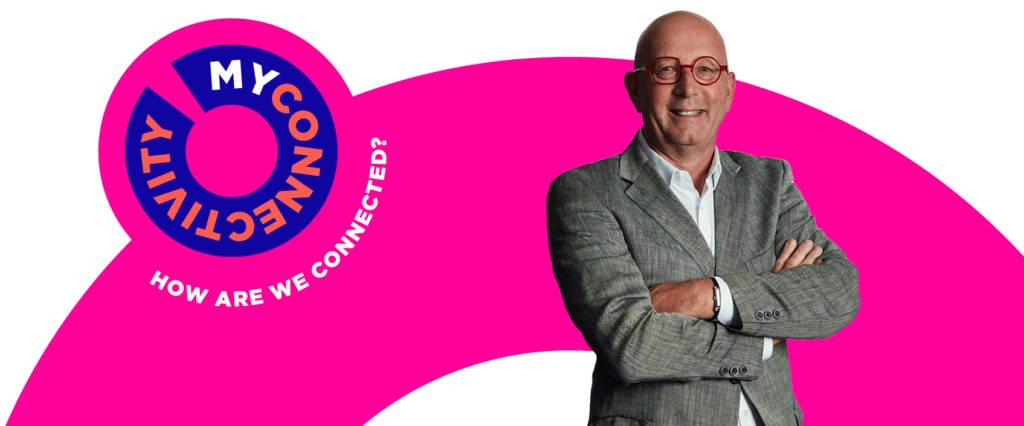
From classrooms to digital landscapes: The evolution of connectivity in education
Scroll
Over the last few decades, connectivity has profoundly transformed education. From the early days of the internet to today’s digital classrooms, technology has shaped the way students and professors interact and convey knowledge. The journey from isolated educational experiences to globally connected environments has been remarkable, and the opportunities for even deeper integration of technology in education are immense.
Prof. Eric Tschirhart teaches Physiology and Technopreneurship at the University of Luxembourg and offers key insights into the evolution of connectivity and its impact on education today. „Connectivity enables people.” According to him, it’s not just about having access to information—it’s about what you do with that access.
Scroll
The past: Getting access to data
The advent of the internet in the mid-1980s opened the door for higher education to experiment with online connectivity. At first, the idea of connecting academic institutions through a global network was groundbreaking. Connectivity went from virtually non-existent to a critical part of educational institutions, offering them access to networks where data could be collected, analysed, and shared. For the first time, educational resources were not confined to the walls of libraries or classrooms but could be accessed from anywhere through the Internet.
By the early 2000s, the commercialisation of the global market accelerated the development of online platforms. Websites became more sophisticated, and while content became more accessible, the Internet also developed into a business. Prof. Tschirhart notes that the most developed commercial websites were at the forefront of technology and drove advancements in web design and development. „Connectivity became a competitive factor in the private sector”. Educational environments benefited largely from these innovations, even though they also entailed some hereto unknown issues.
The almost instant accessibility of online information brought also new challenges to the educational environment. Looking at online sources became so effortless, that students started to challenge the level of truth claimed by teaching materials. In turn, educators then had to communicate and prove how online sources may not always be reliable. This dichotomy between the ease-of-access and untrustworthiness of online information is a dilemma that plagues society to this day.
The introduction of the smartphone marked another turning point. As of then, students could interact with information and data through their fingertips. The smartphone era brought education into the mobile space, further enhancing the accessibility of resources. With this advancement, the way people consume and interact with educational materials changed forever.
The present: Constant interaction with connectivity
Many of today’s classrooms rely heavily on fast, reliable internet connections for delivering educational content and enabling real-time interaction between students and teachers. Since students have immediate access to information online, the format of classes has changed dramatically, forcing professors to adapt their teaching styles and integrate new technologies.
While initiatives such as eduroam, a free global Wi-Fi service for students providing internet access at their universities and in cities across Luxembourg and abroad, made connectivity vastly available to students from all socioeconomic backgrounds, some barriers remain. One major challenge is the difference in access to devices. As Professor Tschirhart puts it: „the size of the screen is crucial”. Access to a tablet or a laptop makes the learning experience a lot more efficient than a smaller smartphone.
Throughout the evolution of connectivity, it has impacted almost all areas of our life and thus, all areas of academic studies. „Everything is impacted by connectivity”; states Prof. Tschirhart, “IT, graphic design, psychology, medicine, sales. Everyone needs to know how to work with technology and use it to make their products and services even better for end consumers.” In this context, the high level of connectivity in Luxembourg enables remote learning and remote work, which positively reinforces the impact it has. Similarly, the network at the University of Luxembourg was planned in advance, is optimised for simultaneous audio and video transfer and ready for the future with dark fibre capacity ready to be expanded as the university grows. Thus, every student can reap the benefits of high connectivity at ultra-fast speeds to enhance their learning.
However, students must be prepared to assess and use information critically, instead of being passive consumers. „Students need to understand how to gather, present, and sell information in a way that is meaningful to their audience”, explains Prof. Tschirhart. Consequently, students cannot simply rely on their technical knowledge but also need to develop the necessary soft skills required to communicate their findings. Students have to be open to knowledge and learn how to organise and structure information. This is why the human connection between students and their professors remains essential. It elevates the quality of human interaction and establishes trust.
The future: AI in the classroom?
In the future, the role of connectivity in education will increase even further. As technologies like artificial intelligence, augmented and virtual reality continue to mature, we can expect them to have a significant impact on how education is delivered.
AI has the potential to revolutionise the educational experience. Prof. Tschirhart is currently working with Amazon Web Services (AWS) on an AI-based proof of concept to create a unique new learning environment for students. „We can use AI to create an interactive and innovative learning and teaching environment”, he explains. By making his teaching material available to an AI system, Prof. Tschirhart envisions a future where students as well as teachers can make use of AI to enrich and improve the teaching experience. An initial test scheduled for this semester aims to explore how AI can help teachers better understand the concepts that students struggle to understand, and how students can use AI as a teaching assistant allowing them to study in new ways and helping them to grasp difficult topics quickly and at ease.
However, Prof. Tschirhart warns against relying too much on AI and emphasises the importance of critical thinking and logical reasoning. „If I had to give students one piece of advice, it would be to consider studying maths or law. These subjects teach you to formalise knowledge, an important skill for all professions today.” He explains that while AI can provide quick answers, it cannot replace the critical thinking coming from human intelligence. „If you ask silly questions, you’ll get silly answers. So, we have to learn to ask the right questions.” Real life environments and settings are crucial for the development of the necessary soft skills required in almost every career. As these skills are more intangible and rely on human-to-human contact, it is doubtful at this point that any type of AI could effectively teach these. In any case, it appears certain that AI will play a significant role in education in the future; what remains to be seen is the exact nature of that role.
The future of connectivity in education goes beyond simply enabling AI systems or improving access to information. It’s about making that information more meaningful and presenting it in ways that positively impact society. Education plays a crucial role in this transformation. With enhanced connectivity, more people can access online resources, regardless of the tools they use. The real challenge lies in ensuring that we leverage these tools to create a better, more connected future for students around the world.

